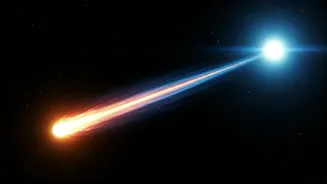Nickel's Unexpected Presence
Comet 3I/ATLAS, known for its interstellar journey, has revealed a secret: the presence of nickel. This finding came as a surprise to researchers, who
typically don't expect to find this heavy metal in such abundance within comets. The discovery required careful analysis of the comet's light spectrum. By studying the wavelengths of light emitted or absorbed by the comet's material, scientists were able to identify the unique signature of nickel. This spectral analysis is akin to a cosmic fingerprint, allowing astronomers to identify the elements present in distant celestial objects. This observation is crucial because it provides valuable data regarding the comet's formation environment, possibly offering clues about its journey. It opens up avenues for understanding the broader processes of the solar system, providing critical details about how our cosmic neighborhood evolved. The analysis also gives scientists the opportunity to better understand the composition of interstellar comets, such as Comet 3I/ATAS.
Decoding the Comet's Past
The discovery of nickel in Comet 3I/ATLAS is important for several reasons. Nickel, as a heavier element, likely formed in the intense environments of dying stars or supernova explosions. When the comet was initially formed, it was likely an amalgamation of dust and gas, left over from the formation of the sun. The presence of nickel could indicate that Comet 3I/ATLAS may have formed closer to a star than our own sun, or it might have originated in a region with more significant stellar activity. This hints at a unique journey, bringing it into our solar system. The presence of nickel, combined with other elemental data, is providing astronomers with insights into the comet's journey. By examining the types of elements and their proportions, scientists can piece together a history of cosmic travel.
Impact on Planetary Science
This discovery also has broader implications for our understanding of the solar system, and how it was formed. Interstellar comets, like 3I/ATLAS, offer a window into regions of space that are usually inaccessible. Every comet has the potential to offer a snapshot of a different stage in the universe's evolution. By studying the composition of these visitors from afar, scientists can learn more about the building blocks of planets and the conditions present during their creation. The data gathered from Comet 3I/ATLAS will be compared with observations of other comets and celestial objects. This comparison might reveal shared characteristics and common formation environments. This will also help to refine existing models of the solar system's origins, thereby providing more accurate descriptions of our cosmic neighborhood.














